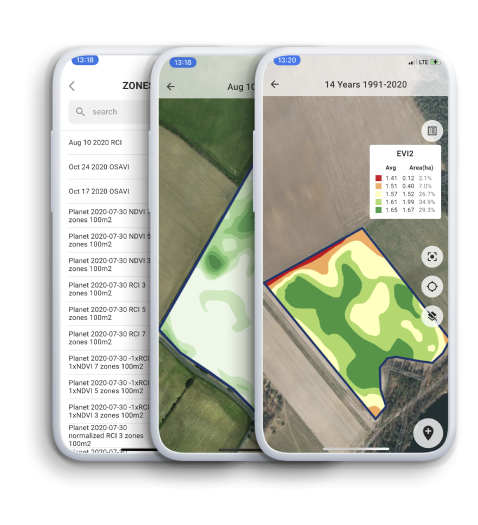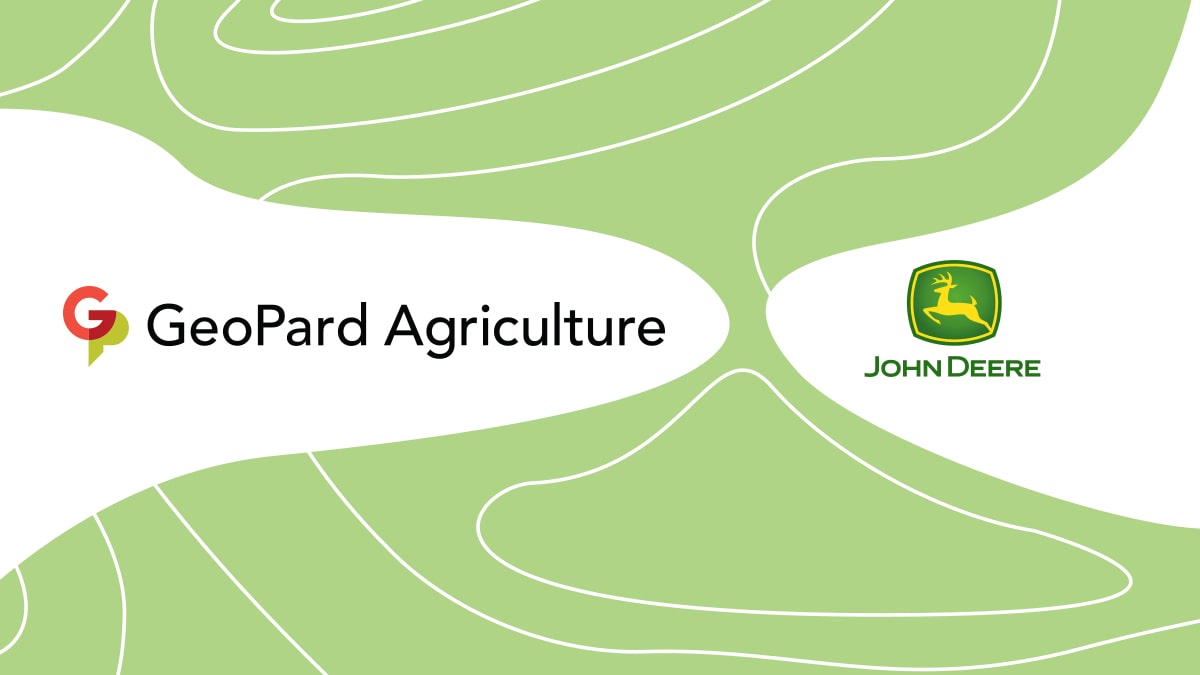The precision agriculture cycle is a continuous process that involves collecting data, analyzing it, and using the resulting knowledge to make informed crop management decisions. Its goal is to optimize resource use and maximize yields while minimizing environmental impact.
Precision Agriculture Cycle
During this, every crop receives the right treatment at the right time and in the right place. This cycle consists of four main stages: data collection, data analysis, decision making and implementation.
1. Data collection
The first step in the cycle is data collection. Information about crops and fields is collected using various instruments and sensors. Soil moisture sensors, for instance, quantify soil water content and temperature, providing valuable insights into the hydration levels of the soil.
Similarly, satellite imagery emerges as a powerful tool, offering comprehensive information about the health and growth of crops. Drones take center stage by capturing high-resolution images of fields, providing a detailed and nuanced perspective that aids in precise analysis.
Meanwhile, weather stations contribute real-time data on climate conditions, encompassing factors such as temperature, humidity, wind speed, and precipitation. Yield monitors play a crucial role in recording the quantity of crops harvested, enabling farmers to evaluate efficiency and predict future yields.

The data collected spans various dimensions – spatial (location-dependent), temporal (time-dependent), or individual (plant or animal-dependent). This categorization serves the overarching purpose of comprehending the inherent variability and heterogeneity within the agricultural system.
Beyond merely gathering information, data collection acts as a diagnostic tool, allowing farmers to swiftly identify and address issues such as pest infestations, diseases, nutrient deficiencies, or water shortages. This proactive approach minimizes potential crop losses and optimizes resource utilization, contributing to the overall health and productivity of the agricultural system.
As farmers gain a deeper understanding of their agricultural systems through data-driven insights, they can make informed decisions that positively impact the long-term health of their fields. However, the global status of data collection in precision agriculture is not just a local concern. It has become a ubiquitous practice, with farmers worldwide embracing these advanced techniques.
Despite the evident benefits, there are scientific concerns regarding data collection, particularly in terms of data security and privacy. As technology becomes more interconnected, ensuring the protection of sensitive agricultural data becomes imperative.
Striking a balance between technological advancement and safeguarding privacy is a critical consideration for the sustainable evolution of precision agriculture.
Furthermore, various factors influence the effectiveness of data collection in precision agriculture. The choice and deployment of sensors, the integration of technology, and the accessibility of data all contribute to the success of data-driven practices.
2. Data Analysis
The transition from data collection to informed decision-making hinges on the pivotal stage of data analysis. This crucial step involves the storage, processing, and interpretation of data obtained from diverse sources, leveraging an array of sophisticated software and platforms.
Various tools come into play during the data analysis phase, each serving a distinct purpose. Cloud computing emerges as a powerhouse, providing the necessary storage and processing power to handle vast volumes of data efficiently.
Artificial intelligence takes center stage, utilizing complex algorithms and models to process and interpret intricate datasets. Geographic Information Systems (GIS) seamlessly integrate geospatial data, offering a visual representation on maps for enhanced understanding.

Dashboards play a vital role by displaying key indicators and trends, presenting a comprehensive overview of the analyzed data.
The primary objective of data analysis is to transcend raw data into meaningful information and knowledge, laying the groundwork for effective decision-making. Beyond this, data reveals valuable insights such as patterns, correlations, and predictions, contributing to a deeper understanding of the subject matter.
Access to well-analyzed data significantly enhances the accuracy and reliability of information and conclusions derived. However, navigating data access challenges becomes imperative. Ensuring data quality, maintaining robust security and privacy measures, and addressing interoperability issues between different systems are crucial facets of overcoming challenges in data access.
The global landscape of data analysis reflects a widespread embrace of advanced techniques across diverse sectors. Global statistics and figures underscore the integral role of data analysis in modern decision-making processes, showcasing its ubiquity in various industries.
The importance of data analysis extends beyond individual sectors, influencing the overall efficiency and efficacy of decision-making processes. Whether in agriculture, healthcare, finance, or any other domain, the ability to extract meaningful insights from data enhances strategic planning and operational efficiency.
The effects of proficient data analysis resonate across different facets of decision-making. It not only enhances accuracy but also ensures the reliability of information, paving the way for well-informed decisions. Furthermore, the insights gained from data analysis empower organizations to anticipate trends, make proactive adjustments, and stay ahead of the curve in a rapidly evolving landscape.
3. Decision Making
The cycle focus in the third stage, decision making, where the focus shifts from data collection and analysis to utilizing the gleaned information for strategic planning and optimization of agricultural operations. This phase leverages insights obtained from accessing data to inform and guide decision-making processes.
One notable example of decision-making tools in precision agriculture is plant models, which have the capability to simulate plant growth and development under different scenarios. These models serve as invaluable assets in supporting decisions related to crop management and optimization strategies.

Decision-making systems within precision agriculture offer recommendations based on agronomic rules or optimization criteria. This functionality enables farmers to make informed choices, taking into account various factors influencing crop productivity.
Additionally, control maps play a vital role by delineating specific areas within a field that require distinct treatments or inputs. Alerts are also integral, promptly notifying farmers or consultants of critical issues or events that demand immediate attention.
The overarching purpose of decision making in precision agriculture is to apply the best available knowledge in order to achieve specific goals within the realm of agriculture. These goals may encompass profit maximization, optimization of resources, or a commitment to environmental sustainability.
Furthermore, the importance of decision making extends to several key dimensions that directly impact agricultural operations, embodies a strategic approach to achieving long-term goals. Firstly, it contributes to increased agricultural productivity, enhancing the overall competitiveness of farming practices.
Secondly, it plays a pivotal role in risk reduction and managing uncertainties associated with crop management. Additionally, effective decision making contributes to the empowerment and satisfaction of farmers, aligning their efforts with optimized strategies.
4. Implementation
The fourth and final step involves the practical implementation of decisions made in earlier stages. This execution phase relies on a myriad of devices and machines, each designed to translate strategic decisions into tangible actions that optimize agricultural operations.
For instance, Variable Rate Technology (VRT) plays a pivotal role in regulating input quantities, such as seeds, fertilizers, or pesticides, based on predetermined regulation maps. Automated irrigation systems, on the other hand, leverage soil moisture data to precisely control the amount and timing of water application.

Robotic harvesters make their mark by efficiently harvesting ripe fruits or vegetables, while smart livestock collars monitor the health and behavior of animals in real-time.
The core purpose of these actions is to implement planned activities promptly and effectively. These activities span various facets, including crop production (planting, fertilizing, watering, spraying, or harvesting) and animal husbandry (feeding, milking, breeding, or healthcare).
The effects of these measures are twofold: they enhance the quality and efficiency of processes while simultaneously reducing the amount of labor and time required.
Furthermore, the objectives governing these activities revolve around ensuring the availability, accessibility, and compatibility of devices and machines. Safety, reliability, and maintenance of systems are paramount considerations, guaranteeing seamless implementation of decisions across the agricultural landscape.
Conclusion
In summary, it is a cycle, encompassing data collection, analysis, decision-making, and implementation, revolutionizes modern farming. Advanced instruments gather information, which is analyzed to guide informed decisions, optimizing operations globally. The cycle’s versatility is seen in various types and uses, with concerns about data security highlighting the need for caution. Efficient management is crucial for seamless integration. As technology advances, addressing concerns and embracing diverse activities remain vital for the continued success of precision agriculture worldwide.
Precision Farming









